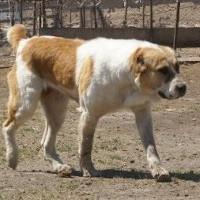 |
Afghan Mountain Dog |
|
He is not recognized by the F.C.I. |
Origin |
Afghanistan | |
Translation |
Francis Vandersteen |
| Descended from the ancient tribal dogs of Tajik and Turkoman, the Djence Sheri is the mountain type of the Koochee sage group. Some regard the Koochee sage as a variant of the Central Asian shepherd dog, while others believe they are the ancestors of all Central Asian breeds. The Afghan mountain dog was even introduced into the Russian Ovcharkas Asian type. Koochee sage means "nomad's dog", named after the nomadic tribes of Afghanistan, and Djence Sheri represents the "lion's dog". This is the largest of the wise Koochee breeds, much more Mastiff in appearance than other types, and resistant to extreme mountain temperatures and humidity. Tall and massive, the Afghan Mountain Dog might seem lethargic, but it's not. Like other wise Koochee dogs, Djence Sheri's movements conserve energy slowly, but is very agile and quick when needed. This large-headed molosser is an excellent climber and a great hunter. Very territorial and aggressive, it doesn't make a good pet. Not very common these days, due to many wars throughout Afghanistan's history, the Koochee sage Djence Sheri is found in mountainous regions, where it is still employed as a working and protection dog for its owners. It has a long, rough coat, this breed can have any color. The average height is around 89 centimeters. |






 English (United Kingdom)
English (United Kingdom)